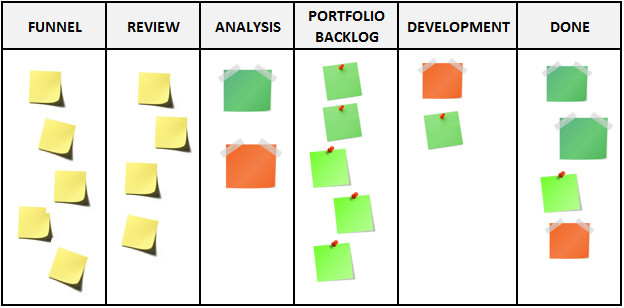Lean and Agile are great approaches to increase effectiveness in Product Development and in Project/Program Management. What could be the most important things to do, to improve the development of your products and services?
[When you will have finished to read this post, take a look at the 2nd part here: 2nd Part – Why (What? How?) you should Embrace Agile and Lean, to Manage your Portfolio]
If you are managing your portfolio of projects using the traditional way, probably you encountered several of the problems listed below.
What? You are already using Agile for Product Development?!
Well, even in that case, if you are stil running you portfolio in a old-fashion traditional way, you will find yourself creating local sub-optimization that, in the very end, will still lead the whole system to create waste and delays.
So, let’s see the reasons that should convince you to use Lean and Agile also at the portoflio level, what to do and how to embrace them.
Problems?
Is your organization suffering from one of these?
- Everything is top priority (means no priorities)
- Projects’ effort is always big one. No short releases, neither MVPs (Minimum Viable Products)
- Too many simultaneous projects
- Too much time passes from ideas generation to product creation
- Waste coming from multi-tasking is huge and not visible
- Technical work is hidden and difficult to explain/justify
- Too much interrupting work
- Lack of visibility of how strategic goals are pursued through initiatives and related priorities, etc.
Well, those are symptoms that your portfolio management needs to be rethought…and not only in terms of practices or tools or techniques.

The most important thing to understand and to work with, resides just beneath the surface: values (and related principles) that drive decisions, behaviors of the people involved in portfolio management.
These are: openness, trust, commitment, focus, collaboration, courage.
Why Agile/Lean Portfolio Management?
This approach, if well understood and applied, will always lead you towards how to produce real and effective value for users: VOC (Voice of the Customer) is paramount.
It strongly organizes work around Value Streams (derived by analyzing VOC) and makes the process flow visible and transparent. Everything is thought to avoid waste. This is done by using pull systems to avoid over-production, limiting WIP (Work In Process), always stressing the importance of quality and making Continuous Improvement a pillar of the whole process.
Visualize your Value Streams
First of all, you need to visualize your Operational Value Stream:
how you are producing, or will produce, value for your customer, visualizing the systematic steps that create value and who is involved in this process, from concept (order) to cash (delivery).
Now, is time to see what systems are used, teams are involved and what features allows the organization to release value through that Operational Value Stream. This collection of teams and systems are called Development Value Stream.
Actually, identifying the people, teams, systems involved and making them consistent and cohesive, is a pillar of Lean/Agile Product and Service development, because the porfolio will be developed around these development value streams and, thus, around these long-lived teams: cross-functional teams which permanently work on same product lines or suites of products.
This concept is a core one when it’s time to talk about capacity. In Agile Portfolio Management, in fact, the smallest unit of measure is actually the team, not single individuals, neither pool of resources assigned for a predetermined amount of time and then moved to other projects (traditional project management).
Funding shall be also arranged according to these value streams, assigning dedicated budget: one budget to one value stream.

Well, in order to start the journey, you need to assess how your portfolio is managed in terms of numbers of project executed, duration, money spent, people and system involved, value delivered, available capacity, etc.
This is a necessary step in order to create the baseline against which to measure the effectiveness of the new approach.
Lift-off the Program/Portfolio Management Team
According to the analysis and the assessment above, you should know who should be part of the team. This team is, again, cross-functional and shall have senior leaders able to make effective decisions, coming from the different organizational areas impacted: IT will obvioulsy be represented (Demand? Architecture? Engineering? Q&A?), Business and others areas as well.
This team shall dedicate some time to create the right Mission, Vision, Objectives and Success Criteria for the portfolio management; this is a very important moment where people start to collaborate and to create team working agreements that specify for example:
- the cadence and frequence when the team meets to work on the portfolio and for how long
- decision making process
- roles and responsibilities within the team
- communication tools, channels, etc.
We usually use the Lift-Off Lean/Agile model to launch these teams.
Again, collaboration, open communication and willingness to work together is key to the success of the initiative.
Agile/Lean Portfolio Management Process Definition
Now is time to define which process (as much lean as possible) to put in place.
This in order to gather any new idea or initiative born in the organization and let them mature in terms of understanding of needs, possible solutions or approaches, any high level analysis of related costs and benefits, to finally arrive to a GO/NO GO decision for the implementation.
The process shall take also into account how to match the demand with the available capacity; here is where the Lean Pull and WIP Limit approaches, come into play.
Lean Portfolio Backlog Prioritization
Lean obsessively fights any waste.
A great concept that helps to avoid spending money for something that has small value, is the Cost Of Delay (COD). It tries to answer to this question:
how much does it cost to your organization, to delay a project in terms of business/user value, time criticality, risk reduction and enablement of new opportunities?
The COD, then, can be divided by the estimated duration of the project, which is the Wighted Shortest Job First (WSJF) that SAFe suggests to be a great tool to prioritize your portfolio backlogs.
Tools
Now it’s time to build your Kanban board which reflect the process above. SAFe suggests the following columns/statuses which are, actually, a great starting point.

The Portfolio team uses the board to visualize the work and the relative flow and cards to show the most important information of each initiative. Every column represent a status of the process:
- Funnel: every new request, idea, initiative arrives here. They are arranged like a queue (FIFO). A standard, lean, minimalist template is used to describe the initative in order to be inserted into the funnel (everything is short and high level: description, top N feature, benefit expected).
- Review: every initiative is, here, quick reviewed to see everything is clear, understood and well described. A very raw estimation of COD and relative effort is done in order to have a first prioritization.
- Analysis: during this phase an Agile Feasibility of the initiatives reviewed in the previous column is done, in order to describe high level: the overal scope, architecture, estimated effort, expected benefits, risks, systems and teams involved, etc. The feasibility is run using Scrum and a virtual cross-functional team is formed that has the final objective to create a lightweight business case that contains the information above mentioned, which helps the portfolio team to take a final GO/NO GO decision.
- Portfolio Backlog: every initiatives arriving from the previous column analysis, with a green light (GO decision), is introduced into the backlog, which is prioritized according to WSJF and here awaits for enough capacity from the teams to be implemented.
- Development: this columns show everything that is under development
- Done: all the initiatives that are finished and put on production are reported into this colums.
Well, we saw many things, but many others are necessary to have an Agile/Lean Portfolio Management in place (e.g. pull system, pull policies, limit WIP, buffers and definition of done, information on cards, definition of value, etc.).
So, let’s discuss it again in one of my future posts.
Be good 🙂
[Take a look at the 2nd part here: 2nd Part – Why (What? How?) you should Embrace Agile and Lean, to Manage your Portfolio]



